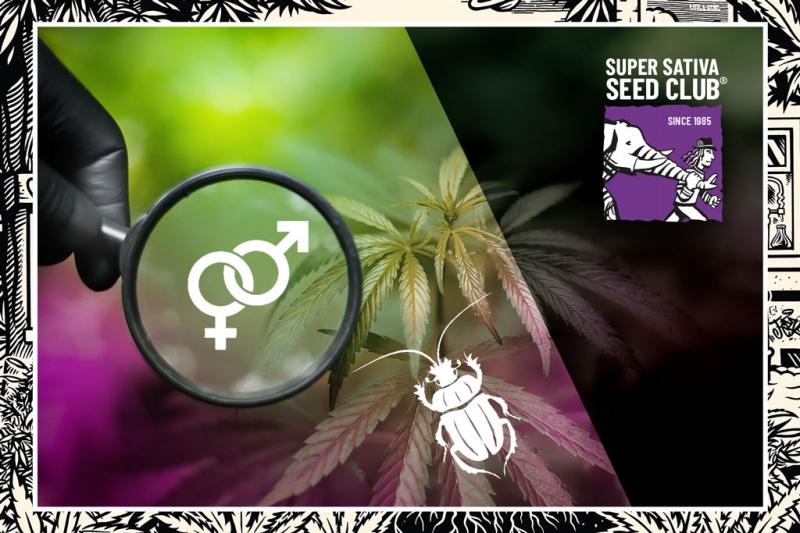
Hi, SSSC-Growers!
In this article of our SSSC Do’s and Dont’s we will look on the first half of the flowering period or flowering phase (called ‚flower‘ in short). That is the time period from the switch to flowering to the appearance of buds on your plant.
The SSSC Do’s and Don’ts Nr.4:
Do’s and Do ’ts for the first half of flower:
DO:
- Ensure 12 hours of darkness
- Check for males and hermaphrodites
- Check for insects and disease
DON’T:
- Disturb the dark-phase
- Let your plants get pollinated
- Wait to battle an infestation
Ensure 12 hours of total darkness:
Once the plants have filled out the grow space nicely and are tall enough, they can be sent into flowering. Cannabis is a photo-sensitive plant, which means that she starts flowering in nature once the daylight starts to decrease (after 21st of June in Europe). Indoors the flowering phase can be induced by changing the light-schedule to 12/12 hours of light/darkness. This happens with a timer plugged into the supply of the grow-lights. The timer is set to 12 hours ON followed by 12 hours OFF. It is very important for the cannabis plant to have 12 continuous hours of uninterrupted darkness, because only then she will ‚think‘ its autumn and start to flower. If the 12 hours are interrupted (e.g. by opening the door to the grow-room or opening the grow-tent and light coming in from the outside for a while) or if there is a hidden light source in the grow area (e.g. a blinking display or the orange LED-light inside the switch of most electric extension cords), the plants will either not start to flower or experience great stress, which in turn will bring out any hermaphroditic genes left in the plant. Light-Stress caused by a light-leak or disturbances in the dark-phase is the main reason for cannabis plants to turn hermie and grow female flowers and male pollen sacs at the same time. Therefore it is of the utmost importance to ensure that the plants experience 12 hours of total darkness. The best way to check for hidden light sources and light-leaks, is to stand inside your closed grow tent or room, when the lights are out, and wait for a few minutes for your eyes to adjust to the darkness. After a few minutes you should still only see black, meaning it should be so dark, that you should not be able to see your hand when you hold it right before your eyes. If you are able to see anything, there is a light-source or -leak and you have to identify and eliminate it (e.g exchange the extension cord to one without a light in the switch or seal the place where light is coming in from the outside). Once you are 100% sure that your cannabis plants are in total darkness when the lights are out, you know they can start their flowering period stress-free.
Check for males and hermaphrodites:
Cannabis plants grown from regular seeds can grow into either female or male plants, while plants grown from feminized seeds should all grow into female plants. For most growers only the female cannabis plants are interesting, because they want to harvest the female flowers (=buds) at the end. Therefore they have to identify and remove the male plants from the grow-area, before the male plants get ripe and release pollen, which would inseminate the female plants and seeds would start to grow inside the buds. Approximately one to two weeks after the switch to flowering, the cannabis plants start to show their sex and from there on you should check them daily or at least every second day.
A female cannabis plant will develop a small pod with two little white hairs (=pistils) coming out, first at the nodes of the plant (=points on the main stem where the side-branches grow out) and then everywhere. Therefore it is best to check the stem of the plant from top to bottom and look at all nodes. If you can see two small white hairs anywhere, you know it is a female plant.
The male cannabis plant develops also a small pod at the nodes, but the pod is sitting on a tiny stem and has no white hairs growing out of it. The pod is the pollen sac of the male plant and will get bigger and start to hang off the tiny stem when it ripens. Once it is ripe, the hanging pod will open up and show 5 tiny little yellow bananas, which hold the pollen of the male plant. The pollen is released immediately after the pod opens up and will be transported by wind through the air and land on the pistils of the female cannabis plants. There the pollen will inseminate the female plant and seeds will start to grow inside the female flowers. Since we want to avoid this, the male plants have to be identified and taken away from the grow area before they get ripe. Best is to cut off the whole male plant at the bottom of the stem and throw it into the trash right away, so no pollen sac can continue to ripen and eventually open up. If you see a little ball with a tiny stem under it growing out of one of the nodes, you know it is a male cannabis plant.
The worst thing for a grower to find, are signs of both sexes on the same plant. If you find a female flower with two white hairs and a male pollen sac on the same plant, you have identified a so called ‚hermie’, a hermaphroditic plant (= plant with two sexes at the same time). Those are very dangerous, because you think the plant is female, since you see lots of white hairs and little buds growing when you look down on her. Unfortunately the male pollen sacs grow sometimes hidden under the female flowers and then can get ripe without being found.
Therefore it is very important to continue to check the main stem and the nodes properly and on a regular basis throughout the whole flowering period. You have to look at them closely and check under female flowers, looking from the bottom up. This will ensure that you find any eventually hidden male pollen sac on time, so you can remove the hermie on time and ensure a seed free grow until harvest.
Check for insects and disease:
While you check the plants for their sex and eventual signs of a hermie, you should also always look at the leaves of the plant and check for signs of insects (e.g. thrips or spidermites) or disease (e.g. powdery mildew). The leaves should have a healthy dark green color without any spots or traces on them.
Two common pests that like to infest cannabis plants are thrips and spider-mites.
Thrips are tiny little insects that eat away on the surface of your leaves and leave little white traces as bite marks. You can see tiny white lines, in a small curve or straight, on the surface of the top-side of the leaves, when you have thrips. They look like a tiny white worm with legs and sometimes wings and are hard to see without magnification.
Spider-mites are also tiny little insects, but they suck on the underside of a leaf and this will cause small yellow spots on the surface on the top-side of the leaf. If you find tiny little yellow specks on your leaves, you should check the bottom-side of the leaf for movement.
You can see small black spots moving around, that look like little spiders under the microscope. If the infestation goes further, you can see a very fine webbing appear around your buds, that's the fine little strings produced by the spider-mites to travel around on your plant. Spider-mites love high temperatures and low humidity, they thrive inside a hot tent in the summer!
The best thing you can do, if you find signs of one of those insects, is to battle them in a biological way, with predatory insects you can order on the internet. In our blog-article next month we will talk about those in more detail.
A very common sickness of cannabis plants is an infection with powdery mildew. Powdery mildew is a kind of fungi (=mushroom), which has spores flying through the air, which infect lots of other plants as well, like grapes, tomatoes or roses. The first sign are white spots on the top-surface of the leaves of your plants. The spots can differ in size from small like a fingernail to as big like a coin. The white spots have a fuzzy white or light grey layer on them, which are the spores of the powdery mildew. Untreated the white spots will grow and eventually the whole leaf-surface will be covered with a white fuzzy layer. This will weaken the plant very much and can kill the plant, so it has to be treated right away. There are different ways to fight powdery mildew, like anti-fungal sprays or UV-C light, which we will also explore in more detail next month.
The most important thing to do, when you find any signs of an infestation or a sickness, is to act right away. The problem will only get worse over time and therefore you have to react immediately and take the right steps to help your plants!
As always we hope our tips will help you to grow your SSSC-seeds to the MAXIMUM and we will continue with the later stages of flower in our following article.
(1024) (0)

